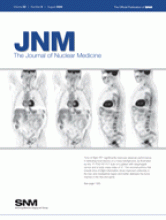Abstract
11C-Pittsburgh compound B (PiB) marks Aβ amyloidosis, a key pathogenetic process in Alzheimer disease (AD). The use of 11C-PiB is limited to centers with a cyclotron. Development of the 18F-labeled thioflavin derivative of PiB, 18F-flutemetamol, could hugely increase the availability of this new technology. The aims of this phase 1 study were to perform brain kinetic modeling of 18F-flutemetamol, optimize the image acquisition procedure, and compare methods of analysis (step 1) and to compare 18F-flutemetamol brain retention in AD patients versus healthy controls in a proof-of-concept study (steps 1 and 2). Methods: In step 1, 3 AD patients (Mini-Mental State Examination, 22–24) and 3 elderly healthy controls were scanned dynamically during windows of 0–90, 150–180, and 220–250 min after injection of approximately 180 MBq of 18F-flutemetamol, with arterial sampling. We compared different analysis methods (compartmental modeling, Logan graphical analysis, and standardized uptake value ratios) and determined the optimal acquisition window for step 2. In step 2, 5 AD patients (Mini-Mental State Examination, 20–26) and 5 elderly healthy controls were scanned from 80 to 170 min after injection. To determine overall efficacy, steps 1 and 2 were pooled and standardized uptake value ratios were calculated using cerebellar cortex as a reference region. Results: No adverse events were reported. There was a strong correlation between uptake values obtained with the different analysis methods. From 80 min after injection onward, the ratio of neocortical to cerebellar uptake was maximal and only marginally affected by scan start time or duration. AD patients showed significantly increased standardized uptake value ratios in neocortical association zones and striatum, compared with healthy controls, whereas uptake in white matter, cerebellum, and pons did not differ between groups. Two AD patients were 18F-flutemetamol–negative and 1 healthy control was 18F-flutemetamol–positive. Conclusion: 18F-flutemetamol uptake can be readily quantified. This phase 1 study warrants further studies to validate this 18F-labeled derivative of PiB as a biomarker for Aβ amyloidosis.
Footnotes
-
↵* Contributed equally to this work.
-
COPYRIGHT © 2009 by the Society of Nuclear Medicine, Inc.







